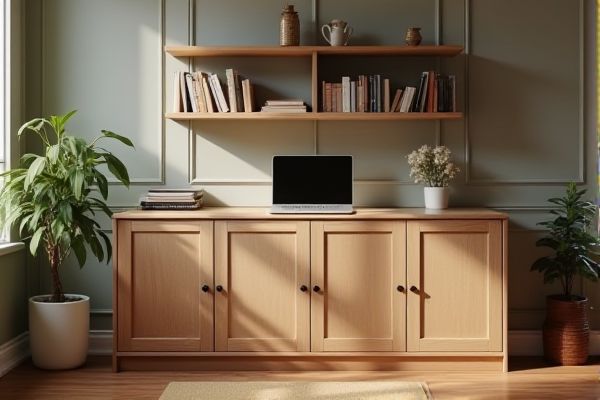
A file cabinet offers organized, secure storage with multiple drawers designed for categorizing documents, making it ideal for long-term use in offices or homes. If you're curious about which option best suits your filing needs and space, explore the rest of the article for detailed comparisons.
Table of Comparison
| Feature | File Cabinet | File Box |
|---|---|---|
| Storage Capacity | Large, multiple drawers | Small to medium, single compartment |
| Portability | Stationary, heavy | Lightweight, easy to carry |
| Security | Lockable with key or combination | Generally no lock or minimal locking |
| Material | Metal or heavy-duty wood | Cardboard, plastic, or light metal |
| Cost | Higher, long-term investment | Lower, budget-friendly |
| Use Case | Office or home for organized, long-term storage | Temporary or portable document storage |
| Space Requirements | Requires dedicated space | Compact, fits on shelves or desks |
File Cabinet vs File Box: An Overview
File cabinets provide secure, organized storage with multiple drawers ideal for filing documents in offices, while file boxes offer portable, lightweight solutions best for temporary or transportable document storage. File cabinets are typically made from metal or wood, ensuring durability and long-term use, whereas file boxes are often made from cardboard or plastic for easy handling. Choosing between a file cabinet and a file box depends on your need for permanence, accessibility, and space efficiency.
Storage Capacity Comparison
File cabinets typically offer greater storage capacity with multiple drawers designed to hold large quantities of letter or legal-sized files securely and in an organized manner. File boxes are portable, compact, and better suited for storing a smaller number of documents or files that require easy transportation and quick access. Choosing between a file cabinet and a file box depends on the volume of documents and the need for mobility versus fixed storage.
Space and Portability
A file cabinet offers more vertical storage capacity, making it ideal for organizing numerous documents in a fixed office space. In contrast, a file box provides enhanced portability, allowing you to easily transport important files between locations. Choosing between the two depends on your need for either substantial space or convenient mobility.
Material and Durability
File cabinets are typically constructed from heavy-duty steel or high-quality wood, offering superior durability and security for long-term document storage. In contrast, file boxes are often made from cardboard or lightweight plastic, providing portability but less resistance to wear and tear over time. Choosing between them depends on your need for robust protection versus mobility and convenience.
Security Features
File cabinets offer enhanced security features such as lockable drawers and sturdy metal construction, providing better protection for sensitive documents. File boxes, typically made of cardboard or plastic, lack advanced locking mechanisms and are more susceptible to damage or unauthorized access. Choosing a file cabinet ensures your important files remain secure and organized in environments requiring higher security standards.
Organization and Accessibility
File cabinets offer superior organization with multiple drawers and compartments that allow for systematic categorization of documents, enhancing quick retrieval. File boxes provide portable and simple storage solutions but often lack the structured separation, making accessibility less efficient for large volumes. Choosing between the two depends on the need for stationary, detailed filing systems versus flexible, temporary document storage.
Cost Effectiveness
File boxes offer a more cost-effective solution compared to file cabinets, especially for individuals or small businesses managing limited storage needs. While file cabinets provide durable, long-term storage with organizational features, file boxes are affordable, portable, and require less space, making them ideal for budget-conscious users. Your choice depends on balancing upfront costs with storage capacity and convenience.
Ideal Use Cases
File cabinets excel in office environments where secure, organized storage of large volumes of documents is essential, offering locking mechanisms and multiple drawers for categorization. File boxes are ideal for temporary or portable storage needs, suitable for personal use or smaller collections of files that require easy transport and quick access. Your choice depends on whether you prioritize long-term organization and security or lightweight mobility and convenience.
Maintenance and Care
File cabinets require periodic lubrication of drawer tracks and tightening of hardware to ensure smooth operation and prevent wear. File boxes demand minimal maintenance but should be kept dry and clean to avoid damage from moisture or dust accumulation. Proper care extends the lifespan of both options, with file cabinets benefiting from mechanical upkeep and file boxes from environmental protection.
Choosing the Right Storage Solution
File cabinets provide secure, organized storage with multiple drawers ideal for long-term document management in offices, while file boxes offer portability and compactness suited for temporary or home use. Choosing the right storage solution depends on space availability, volume of files, and accessibility needs. Evaluating factors like security features, ease of transport, and capacity ensures optimal file management efficiency.
 homyna.com
homyna.com